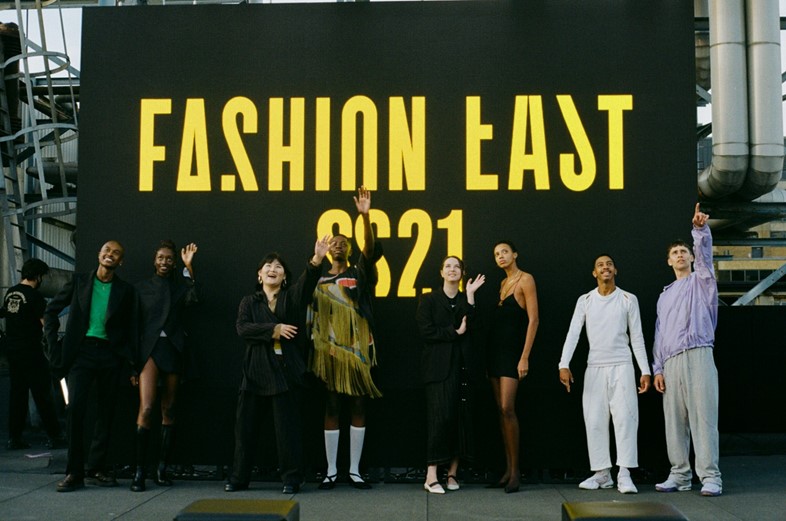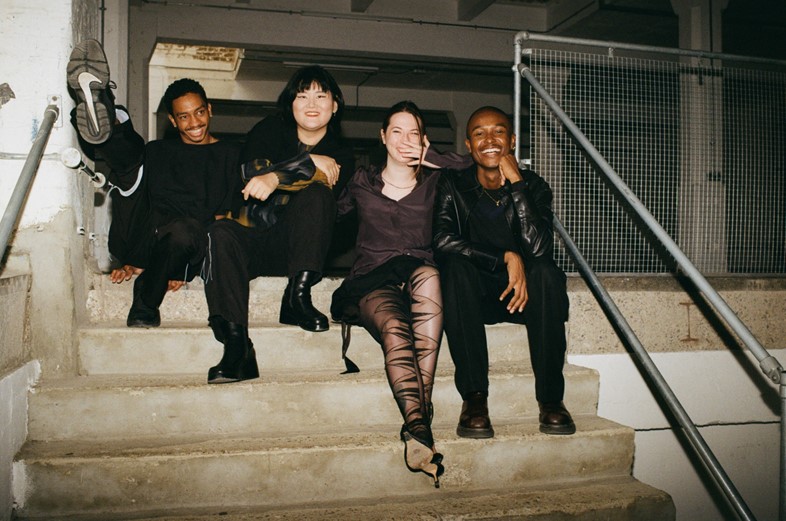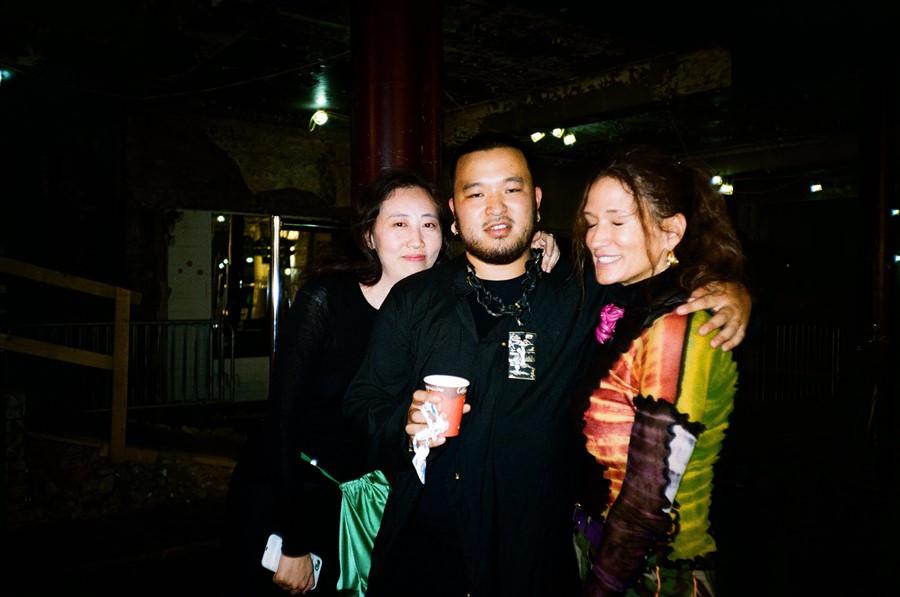Fashion East is responsible for launching the careers of some of Britain’s brightest fashion talents. In the wake of its 20-year anniversary show this past weekend, founder Lulu Kennedy charts the history of the unique fashion launch pad
Despite her protestations – “I’ve always liked to mind my business and lurk in the background” – Lulu Kennedy is the beating heart of Fashion East, the talent incubator she launched at the turn of the milennium. Begun by happenstance on Kennedy’s return from Naples, Italy, where she organised warehouse raves in the 1990s, to Shoreditch, London, Fashion East has since ushered in the careers of Britain’s brightest talents: Kim Jones, Jonathan Anderson, Craig Green, Grace Wales Bonner, Simone Rocha, Gareth Pugh, as well as a younger generation of designers altering fashion’s landscape, Mowalola Ogunlesi, Charlotte Knowles, Saul Nash and Stefan Cooke among them. And the list goes on.
This past weekend, Kennedy – alongside her team and the panel of experts who help her pick the designers who show each season – celebrated 20 years of Fashion East with a series of films by this season’s designers. In the wake of Covid-19 restrictions, it was perhaps not the celebration Kennedy might have once envisaged (her packed after-show parties are both notorious and legendary) but the presentation nonetheless felt as enlivening as ever. “I have actually loved not doing a show,” Kennedy admits. “I am in awe of the resilience and acceptance [the designers] have shown. They have literally been grafting alone all summer.” Those designers include Saul Nash, Nensi Dojaka and GOOMHEO, who each made their return this season, joined by newcomer Maximilian Davis. Befitting a celebration of Kennedy’s knack for discovery, Davis’ Rafael Pavarotti-shot, Ib Kamara-styled collection – which drew inspiration from Trinidadian Carnival, and celebrated Black elegance – propositioned him as one of London’s most exciting names to watch.
Asked what keeps her going after two decades in an industry which is famously fickle, Kennedy says the next generation of designers – “the kids” – are the source of her unyielding energy. “They never fail to surprise and delight me with their ideas, intention, execution, originality, strength,” she says. Those who have passed through Fashion East are equally energised by Kennedy’s dedication, which often extends far beyond her role as Fashion East’s founder – over the course of a season, she can be mentor, matriarch and therapist in equal measure. “Without Lulu I don’t think I would be doing what I do now,” says Craig Green, who showed for three seasons at Fashion East beginning in 2014. Simone Rocha concurs: “For Lulu to shine her light on you was so special, just out of college and trying to share your voice, creativity, and identity, she gave me that platform.” “I honestly believe that Lulu sees things in people that others never would, she’s been an incredible mentor,” says International Woolmark Prize-winning designer Richard Malone. “We need so many more Lulus in the world, but of course there is only one.”
Here, in celebration of 20 years, Kennedy tells AnOther the story behind Fashion East – from the “brilliant mess” of the first ever showcase to the future of London fashion she hopes to see.

Jack Moss: Tell me about how Fashion East first began – what was the impetus behind it? Did you ever envisage it becoming what it has become today?
Lulu Kennedy: It started almost by accident. I had moved back to the UK from Naples in 1995 and [ended up] in Shoreditch. I met the guy who had just bought the Truman Brewery in an art gallery and he offered me a job. I got into hiring out their industrial warehouses for art shows and parties, and catwalk shows. I was friends with local designers House of Jazz [Pablo Flack and Robinson] who wanted to do a show but were skint, so I hustled them a free warehouse off the owner. I made the mistake of getting the floor cleaned and it somehow ended up slippy like an ice rink for the poor models; Katie Grand styled and Nathan Gregory Wilkins was playing Whitney Houston and Sugababes bootlegs – it was electrifying and I got beside myself with happiness, as I do! I knew then that all I wanted to do was help my talented mates. Luckily Truman’s owner was very into the idea of being philanthropic, and let me run with the idea of a project for young designers. They’ve been the patrons ever since.
JM: What did London look like back then? Particularly east London …
LK: It was a lot of fun in east London. Rents were so cheap that everyone could have a loft to work in by day and party by night. It was lawless and empty, with nowhere to even buy food, never mind a nice coffee – we used to just live on snacks from the Texaco on Shoreditch High Street or Brick Lane bagel shop. The Bricklayers Arms was our second home, I used to look after the bar while David Waddington went down to the cellar to change a barrel. I would be making drinks for Guido and Jarvis Cocker, it was all very fab.
JM: What do you remember about the first Fashion East show?
LK: The first ever Fashion East was a brilliant mess. I had no idea what I was doing or how the industry worked, but I was happy it blew up straight away. We had some weird corporate sponsorship from a vodka brand that sat very strangely next to our designer’s aesthetic but I was happy we had booze. The door was mad, it was packed – with lots of cheering – and a crazy afterparty. I guess I was comparing it to the raves we had been putting on in Naples and judged it a success, but with hindsight it was a shambles!
JM: How were you initially choosing the designers? Were they mostly friends? What made a good designer stand out?
LK: At first it was a mixture of who I knew and liked, plus designers chosen by a panel of industry experts that had been put together for me as I only knew fashion people from the pub. It could be a bit hit and miss. I preferred it a few years in when I had met the main players I rated and could make my own instinctive decisions. But some panel members really took me under their wing and are major allies and friends to this day – Mandi Lennard, Harriet Quick and Charlie Porter among them.
JM: What are some of your other memories of those early seasons?
LK: I was always punching above my weight and budget, and that hasn’t changed. One season I gave each of the three designers a floor of a giant warehouse so they could have their own solo show and set design and lighting. Some of the audience moaned about having to move around a building and be seated three times. I hadn’t thought of that – I should have just done bloody standing only! Another memory is meeting Louise Wilson. I had heard all these designers talking about her and was desperate to meet her myself. She did not disappoint! I was enthralled. After that, I only really cared about what Louise thought of our shows. She was my main critic.
JM: In the moments before a show, how do you feel?
LK: Sick. Butterflies. That’s not changed in 20 years.
JM: Does Fashion East feel different now? Do you think London fashion has changed?
LK: I think the British Fashion Council became a lot more involved with young designers and got more funding. Back then they used to only have a few places on their NewGen scheme and it was very hard to win. Now I can’t keep up with all the schemes they are doing for young designers. There’s a lot more choice, but as a result it does feel more corporate. I liked it when things felt more odd and off-schedule.
JM: Has the way you pick designers changed?
LK: No, I still pick them by seeing how they visually present their work to me when they apply, and also the tone of their Instagram is an interesting insight into their world.
JM: Is there a moment you are particularly proud of? Or a designer that has really changed your life and perspective?
LK: Richard Nicoll became one of my closest friends and definitely changed my life and many others. His style, optimism, kindness and humour just flowed, and drew everyone to him. Wherever Rich was, the fun was. He always gave me excellent advice and encouragement.
JM: How about an item of clothing?
LK: The designers had Judy Blame make me some brooches using their name labels, buttons, safety pins, jingle-jangle. They are beyond precious to me. I adored Judy.

JM: You are celebrating 20 years of Fashion East this year – did you ever imagine in the beginning it would still be going in 2020?
LK: Absolutely not! I’m not one for making a plan, it has honestly caught me by surprise! I feel the same way about turning 50 ... like WTF happened there? [Laughs]
JM: How are you celebrating?
LK: Finding ways despite the pandemic is not easy. We may have to have a belated mega bash when it’s safe to ...
JM: You aren’t doing a runway show this season – does it feel disappointing, or like a needed break?
LK: I have actually loved not doing a show. Embracing this time and change feels the right way to approach it.
JM: How have you found this season’s designers have been coping with lockdown?
LK: I am in awe of the resilience and acceptance they have shown. They have literally been grafting alone all summer. How did they make not only collections but films? Young legends!
JM: A lot has been said about this being a moment of change. What are some of the changes in fashion you would like to see?
LK: I’m really relieved to see the changes already coming through. Things had got so toxic and stupid it couldn’t have carried on for much longer. The pandemic and cultural revolutions happening globally has accelerated these necessary changes.
JM: What is the first thing you tell designers when they become part of Fashion East?
LK: Keep your head down and focus on the work, avoid hype, gossip, fluff and distraction. I’ve always liked to mind my business and lurk in the background – Fashion East should be about the designers not me.
JM: What still excites you about fashion 20 years on?
LK: The kids! They never fail to surprise and delight me with their ideas, intention, execution, originality, strength. Also my own team and collaborators I work with on a daily basis like Raven PR and the Nike gang, who are absolutely the best people in the business. We keep the mood up and work out problems together. I wouldn’t and couldn’t do it without them.
JM: What does the future hold? What’s next for Fashion East?
LK: We are only getting started!
